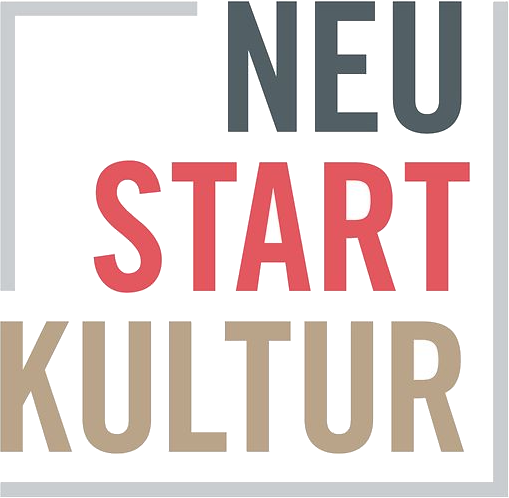Group Show „Green space. Place Internationale“ with Stephen Willats
13.06.2019 - 17.08.2019
Opening: Thursday, June 13th, 2019, 7 pm
ngbk – neue Gesellschaft für Bildende Kunst, Maxie-Wander-/Ecke Carola-Neher-Straße, 12619 Berlin-Hellersdorf (U5 Cottbusser Platz)

For summer, the station urbaner kulturen / nGbK Hellersdorf’s activities will be moving to the green land we call „Place Internationale“ on the Hellersdorf housing estate: Green space »Place Internationale«, Maxie-Wander-/Ecke Carola-Neher-Straße, 12619 Berlin-Hellersdorf (U5 Cottbusser Platz).
Tours: Thur+Sat, 3 – 6:30 pm.
Contact: 0173 - 20 09 608, e-mail: station-urbaner-kulturen@ngbk.de. Beginning on Thursday, 13th June 7pm.
Exhibition opening „GOING OUT OF CIRCLES. Housing estates and the production of images of themselves. Part 3 Tiblisi-Gldani / Berlin-Gropiusstadt“ with 8 billboards by Stephen Willats and Tinatin Gurgenidze & Christian Hanussek.
Opening of the new meeting place on the green land as part of the project „The periphery is alive - the Hellersdorf housing estate yesterday, today and tommorow“.
Programme June – August 2019:
Sunday, 16 June 2019, 4 pm (in German)
Gldani: History, Urban Planning and Reworking.
Filmscreening and lecture by Tinatin Gurgenidze.
Sunday, 21 July 2019, 2:30 - 5:30 pm.
Cricket Festival with AC Berlin and Hellersdorf Cricket Club, 6 pm .
Nicht mehr, noch nicht, by Daniel Kunle & Holger Lauinger, DE/OmU (eng), 2004
Filmscreening and discussion with Holger Lauinger.
Saturday, 10 August 2019, 6 pm (in German).
The Map Factory as a home for refugees
Filmscreening and lecture by Tinatin Gurgenidze.
Saturday, 17 August 2019, 2:30 - 5:30 pm.
Cricket Fest with AC Berlin and Hellersdorf Cricket Club, 6 pm (in German).
The Tiblisi Architecture Biennial.
Lecture by Tinatin Gurgenidze.
Free entrance. Everyone is welcome.
Background information:
»GOING OUT OF CIRCLES. Housing estates and the production of images of themselves«. Part 3: Tiblisi-Gldani / Berlin-Gropiusstadt.
In the third part of the exhibition series, text and image collages will be shown on billboards at Place Internationale near the station urbaner kulturen. The artist Christian Hanussek and the architect Tinatin Gurgenidze deal with the large Gldani housing estate in Tbilisi while the artist Stephen Willats focuses on Berlin’s Gropiusstadt estate.
Tinatin Gurgenidze’s & Christian Hanussek’s series »We have everything…« presents insights into life on the huge Gldani housing estate, home to about 30% of Tbilisi’s 1 million inhabitants. The estate was built on open land on the northern edge of the city as part of the 1970 General Plan and was ambitiously designed as a self-functioning urban infrastructure. Since the end of the socialist era, residents have randomly filled spaces between the tower blocks with garages and added self-made extensions to the flats (notoriously termed »Kamikaze loggias«). This post-socialist transformation and, at times, brutal appropriation of the estate’s original masterplan has enabled parallel microeconomies to flourish, ensuring many residents’ financial survival as well as a revival of the public domain through social interaction.
Stephen Willats has been making artistic interventions into the social fabric of society since the early 1960s. He involves people in the creative process of making his work and seeks to define art as a social practice. His series »Living in isolation« was created in 1979/80 on Berlin's Gropiusstadt housing estate in collaboration with the resident Klaus Müller, whose large apartment in a high-rise tower is a symbol of isolation in Willats' four images. The work focuses on the physical and psychological pressures to which individuals are exposed through isolation in society. It describes in words and images a diversity of personal spaces created within set structures and anonymous architectures, and how people create self-organized social and creative networks as part of their struggle for expressions of personal identity and a sense of community.
Exhibition series »GOING OUT OF CIRCLES. Housing estates and the production of images of themselves« since May 2018
The visual arts and artistically informed urban research are increasingly converging in the field of ‘urban cultures’. Art and culture as well as urbanity and built space need to be explored, experienced and narrated. One field of engagement in recent years has been large housing estates built in the heroic phase between 1960 and 1990. They possess dimensions that are alone comparable to a small town – yet crucial urban functions such as the arts and cultural life are foremost projected onto the city centre. For this reason, large housing estates remain oddly foreign to many people in the city.
New narratives and images are needed to break open the seeming homogeneity of housing estates and to fathom their fascinating contradictoriness.
Housing estates are comparable to one another – even across continents. They are often organized in concentric circles around the core city. But even within one city, contact between housing estates is rare.
The exhibition project GOING OUT OF CIRCLES in the district of Hellersdorf builds bridges within Berlin as well as further afield to partner housing estates and partner cities. It asks how stereotypes of a place are formed, how they are attributed from the outside and how they are accepted and continued internally? And how in the periphery, visual strategies exist which do not impose an ‘image’ from the outside but are developed through the self-will of the residents themselves? With its strategies of pictorial narration and visual knowledge, art can carry special significance for these questions.
(Images: left, Tinatin Gurgenidze & Christian Hanussek from the series »We’ve got everything…«, Gldani 2019. Right, Stephen Willats from the series »In Isolation leben«, Gropiusstadt 1979/80. Four panels, here: third panel.)


